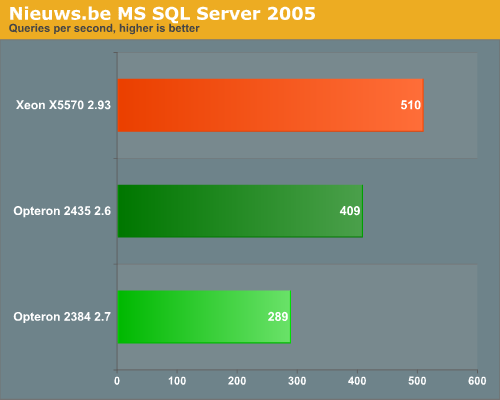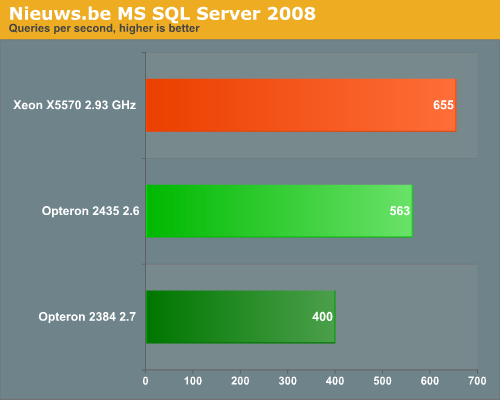Decision Support benchmark: Nieuws.be
Operating System: Windows 2008 Enterprise RTM (64 bit)
Software: SQL Server 2008 Enterprise x64 (64 bit)
Benchmark software: vApus + realworld “Nieuws.be” Database
Database Size: > 100 GB
Typical error margin: 1-2%
The Nieuws.be site is sitting on top of a pretty large database: more than 100 GB and growing. This database consists of a few hundred separate tables, which have been carefully optimized by our lab (the Sizing Servers Lab). We have described our testing methods here in more detail. As some of our readers suggested we upgraded from SQL Server 2005 SP3 to SQL Server 2008. This gave a boost of 29 to 38% (!) to the performance of our decision support database. All configurations use 2 sockets. Take a look at the MS SQL Server 2005 numbers:

And compare with the numbers on SQL Server 2008.

SQL Server 2008 is clearly better optimized for the complex queries that an OLAP database has to absorb.
Back to the hardware. In both cases, you can clearly see that this workload depends less on “uncore” factors (caches, memory bandwidth) than the OLTP test. The Opteron 2435 is a healthy 41% faster than the 2.7 GHz Opteron 2384. A 2.6 GHz quad-core Opteron would score about 385, which means that the scaling from 4 to 6 cores is excellent: 46%. That kind of scaling is very close to the theoretical maximum of 50%, but it is not enough to beat the newest Xeon, which sees its advantage shrink to a 16% lead. However, as the Opteron 2435 competes with 2.66 GHz Xeon and not the Xeon 2.93 GHz, this is the first benchmark where “Istanbul” is competitive. In sharp contrast with the quad-core “Shanghai”, which does not have a chance against the Xeon X55xx armada.










40 Comments
View All Comments
iocedmyself - Wednesday, June 17, 2009 - link
Well something that was failed to be mentioned was that the 2P opteron machine costs about $6700, where as the nehalem 2p machine is very near to $16,000.as for power consumption a straight up comparison would be HP380 Xeon and HP 385 Opteron. At idle, both are 140W. With 100% CPU / Ram, 385 is around 300W, 380 (Xeon) is about 450W.
another thing not discussed here - 4P Istanbul is 70-80% faster than 2P Nehalem, and there is no 4P Nehalem. 8P Istanbul is over 3 times as fast as 2P Nehalem. so until next gen Nehalem, there is no competition in the high end which probably has something to do with istanbul orders being through the roof.
I also have to wonder if these benchmarks were conducted using one of Intel's little helpful optimized compilers.
yasbane - Wednesday, June 10, 2009 - link
would be nice to see some unix or linux benchmarks...riskyburden - Thursday, June 4, 2009 - link
I might be naive here but surely the majority of these applications are favouring clock speed and no more than two cores, should there not be a bench for those companies that run multiple apps such as SQL and AD or IPFX etc all from one server and make a comparison there. I don't suggest it to be good network practice but that would interest me more.mino - Friday, June 5, 2009 - link
For this part of SMB market pretty much any dual core CPU will do.Their bottleneck is almost allways on the storage side, sometimes with insufficient memory.
And most also run default install where basic SW tweaks would make 100's percents in performance.
befair - Wednesday, June 3, 2009 - link
Johan never proves me wrong. Even an article meant to talk about AMD Opteron starts with a good deal of "Intel is the king!" stuff, as usual.alpha754293 - Wednesday, June 3, 2009 - link
What happened to them?I would have to loved to have seen what the new 6-core AMDs would be able to do in this arena since it is (presumably) a much more competitive offering than the fastest Xeons all around.
lopri - Tuesday, June 2, 2009 - link
A Question: Is the 'snoop-filter' a hardware-based? I read that it can be enabled/disabled via BIOS, and since the cores are same as Shanghai cores.. But my question is, whether it's hardware-based or software-based (BIOS), shouldn't this work for inter-core communication as well if AMD decides to implement it?JohanAnandtech - Tuesday, June 2, 2009 - link
I have to check, but I am pretty sure it is both. The "uncore" part has changed somewhat on Istanbul."shouldn't this work for inter-core communication as well if AMD decides to implement it"
Since the L3-cache keeps copies of shared L2-cachelines, I don't think that will help. There is already a very fast way of communicating with little overhead.
tygrus - Monday, June 1, 2009 - link
I would like to know the performance difference when using a cell size of 3 not 6 on the 6-core units or of 8 not 4 on Xeon 4Core8Thread ?Will have to wait for latter for more raw performance numbers (eg. memory local/system, SPEC CPU, task switching, OS/IO task servicing).
How long before they update the boards for DDR3 based memory and better IO onboard ?
It's a pity the ESX 4.0 update hasn't helped AMD .. are the improvements only available for Intel or was it to correct a previous Intel only problem ? What can AMD/partners do to improve performance ?
JohanAnandtech - Tuesday, June 2, 2009 - link
"I would like to know the performance difference when using a cell size of 3 not 6 on the 6-core units?"A cell size of 3 will not do any good if your VMs are MP. Eventhough ESX features "relaxed co-scheduling", there might quite a few cases where the Scheduler is not able to use all "slots" as some of vCPUs of the VMs might be behind. From the momemt you use more than 2 vCPUs, you will get situations where only one VM with 2 CPUs is scheduled on a cell of 3 CPUs. 8-cell: I have to try it.
"How long before they update the boards for DDR3 based memory and better IO onboard ? "
The AMD's Fiorano platform that will be available in a few weeks should have better I/O (PCIe gen 2) but will still be DDR-2 based.
DDR-3 CPUs are scheduled for 2010.
"It's a pity the ESX 4.0 update hasn't helped AMD .. are the improvements only available for Intel or was it to correct a previous Intel only problem ? "
VMware's docs tell us they that CPU locking goes more quickly and that the scheduler is "cache aware", but most of the biggest improvements are EPT and better support for Hyperthreading.